seats FORD MUSTANG 1999 4.G Owners Manual
[x] Cancel search | Manufacturer: FORD, Model Year: 1999, Model line: MUSTANG, Model: FORD MUSTANG 1999 4.GPages: 216, PDF Size: 1.72 MB
Page 20 of 216
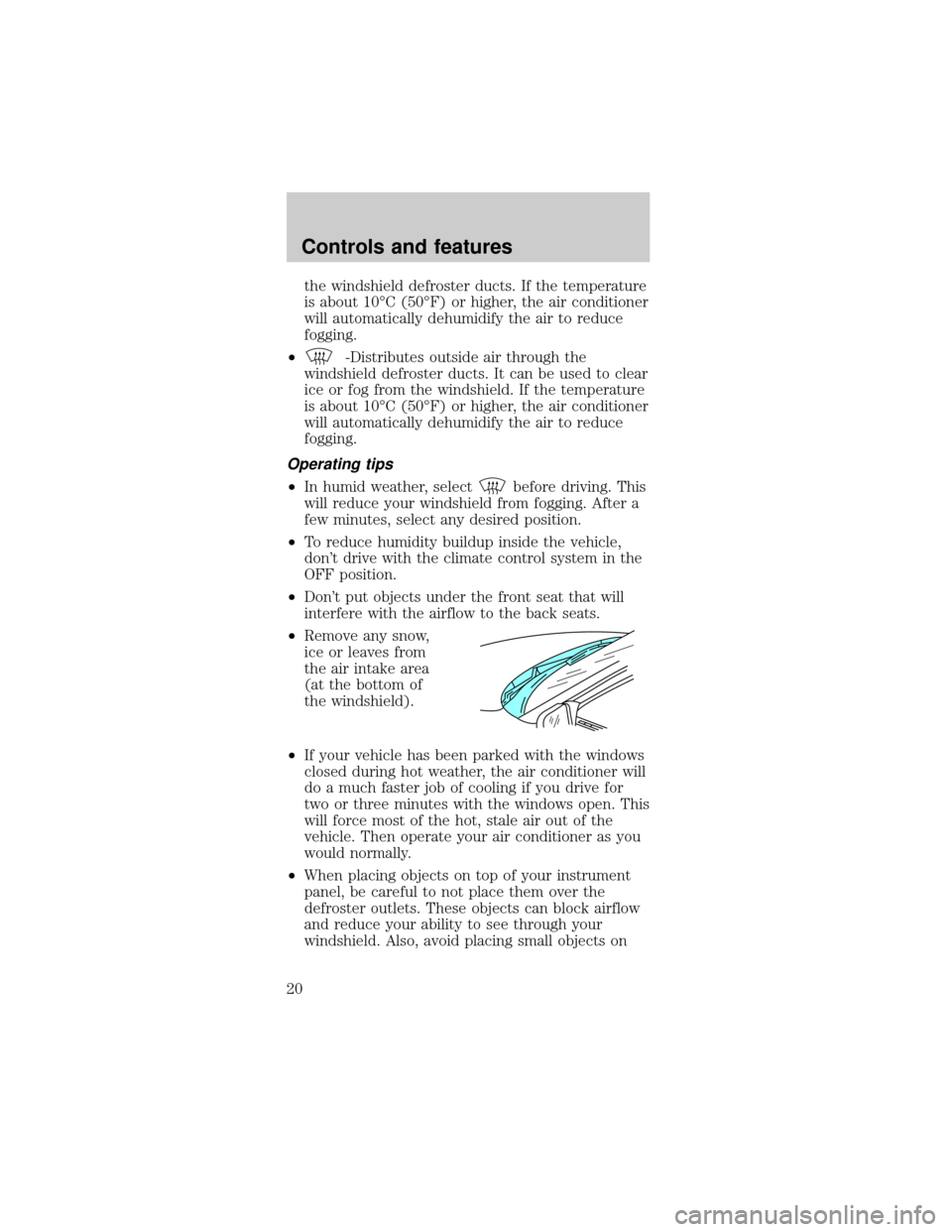
the windshield defroster ducts. If the temperature
is about 10ÉC (50ÉF) or higher, the air conditioner
will automatically dehumidify the air to reduce
fogging.
²
-Distributes outside air through the
windshield defroster ducts. It can be used to clear
ice or fog from the windshield. If the temperature
is about 10ÉC (50ÉF) or higher, the air conditioner
will automatically dehumidify the air to reduce
fogging.
Operating tips
²In humid weather, selectbefore driving. This
will reduce your windshield from fogging. After a
few minutes, select any desired position.
²To reduce humidity buildup inside the vehicle,
don't drive with the climate control system in the
OFF position.
²Don't put objects under the front seat that will
interfere with the airflow to the back seats.
²Remove any snow,
ice or leaves from
the air intake area
(at the bottom of
the windshield).
²If your vehicle has been parked with the windows
closed during hot weather, the air conditioner will
do a much faster job of cooling if you drive for
two or three minutes with the windows open. This
will force most of the hot, stale air out of the
vehicle. Then operate your air conditioner as you
would normally.
²When placing objects on top of your instrument
panel, be careful to not place them over the
defroster outlets. These objects can block airflow
and reduce your ability to see through your
windshield. Also, avoid placing small objects on
Controls and features
20
Page 64 of 216
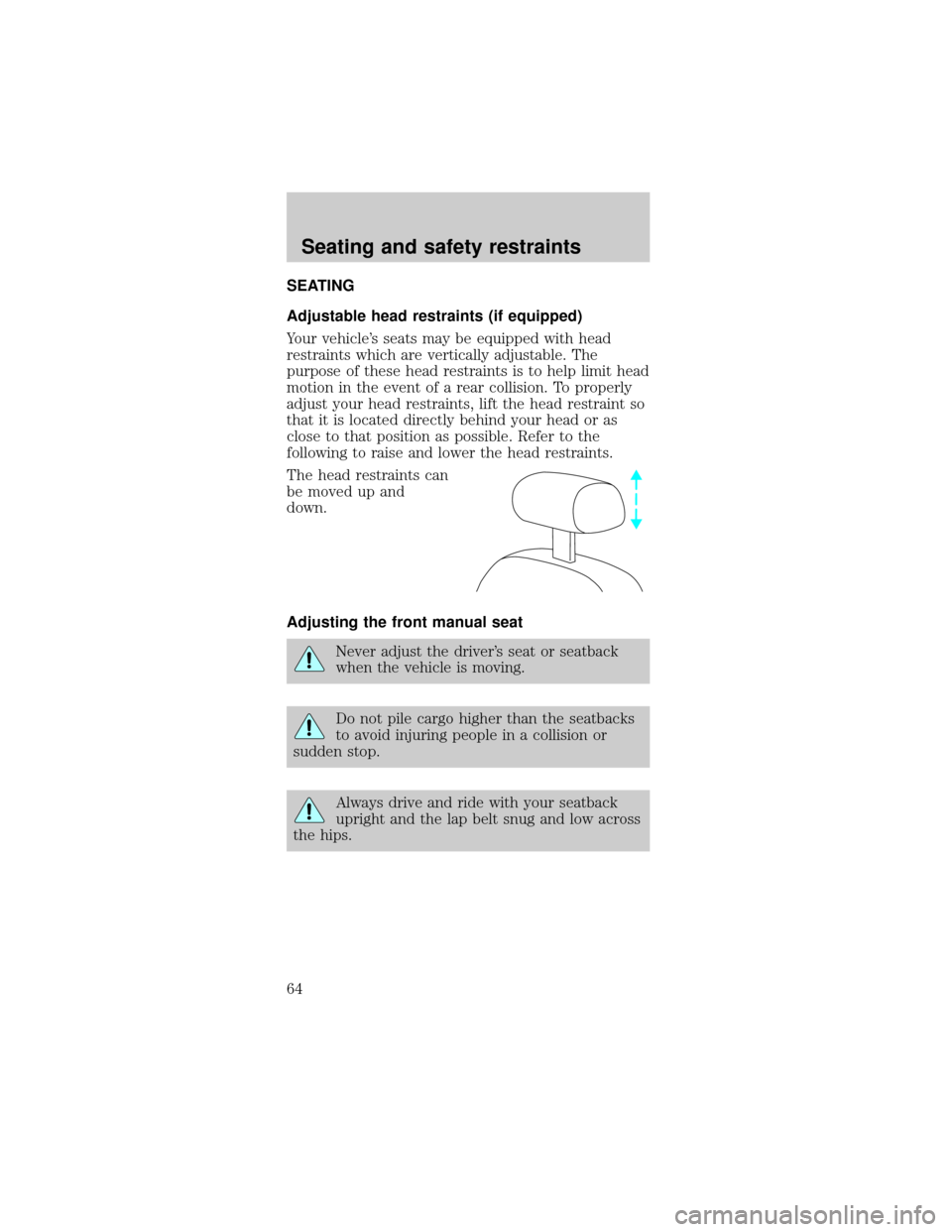
SEATING
Adjustable head restraints (if equipped)
Your vehicle's seats may be equipped with head
restraints which are vertically adjustable. The
purpose of these head restraints is to help limit head
motion in the event of a rear collision. To properly
adjust your head restraints, lift the head restraint so
that it is located directly behind your head or as
close to that position as possible. Refer to the
following to raise and lower the head restraints.
The head restraints can
be moved up and
down.
Adjusting the front manual seat
Never adjust the driver's seat or seatback
when the vehicle is moving.
Do not pile cargo higher than the seatbacks
to avoid injuring people in a collision or
sudden stop.
Always drive and ride with your seatback
upright and the lap belt snug and low across
the hips.
Seating and safety restraints
64
Page 69 of 216
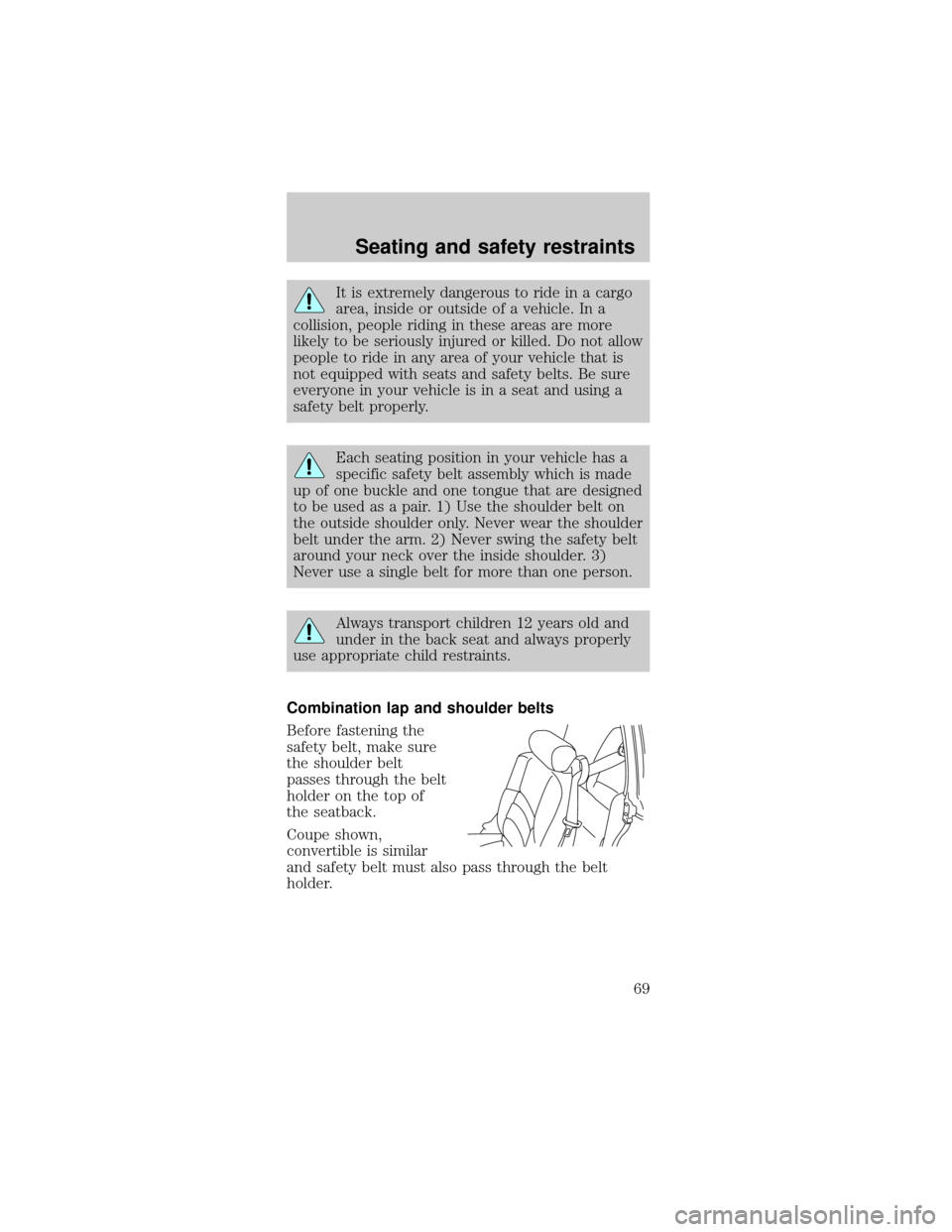
It is extremely dangerous to ride in a cargo
area, inside or outside of a vehicle. In a
collision, people riding in these areas are more
likely to be seriously injured or killed. Do not allow
people to ride in any area of your vehicle that is
not equipped with seats and safety belts. Be sure
everyone in your vehicle is in a seat and using a
safety belt properly.
Each seating position in your vehicle has a
specific safety belt assembly which is made
up of one buckle and one tongue that are designed
to be used as a pair. 1) Use the shoulder belt on
the outside shoulder only. Never wear the shoulder
belt under the arm. 2) Never swing the safety belt
around your neck over the inside shoulder. 3)
Never use a single belt for more than one person.
Always transport children 12 years old and
under in the back seat and always properly
use appropriate child restraints.
Combination lap and shoulder belts
Before fastening the
safety belt, make sure
the shoulder belt
passes through the belt
holder on the top of
the seatback.
Coupe shown,
convertible is similar
and safety belt must also pass through the belt
holder.
Seating and safety restraints
69
Page 71 of 216

The automatic locking mode is not available on the
driver safety belt.
When to use the automatic locking mode
²When a tight lap/shoulder fit is desired.
²Anytimea child safety seat is installed in a
passenger front or outboard rear seating position
(if equipped). Refer toSafety Restraints for
ChildrenorSafety Seats for Childrenlater in
this chapter.
How to use the automatic locking mode
²Buckle the
combination lap and
shoulder belt.
²Grasp the shoulder
portion and pull
downward until the
entire belt is
extracted.
Seating and safety restraints
71
Page 79 of 216
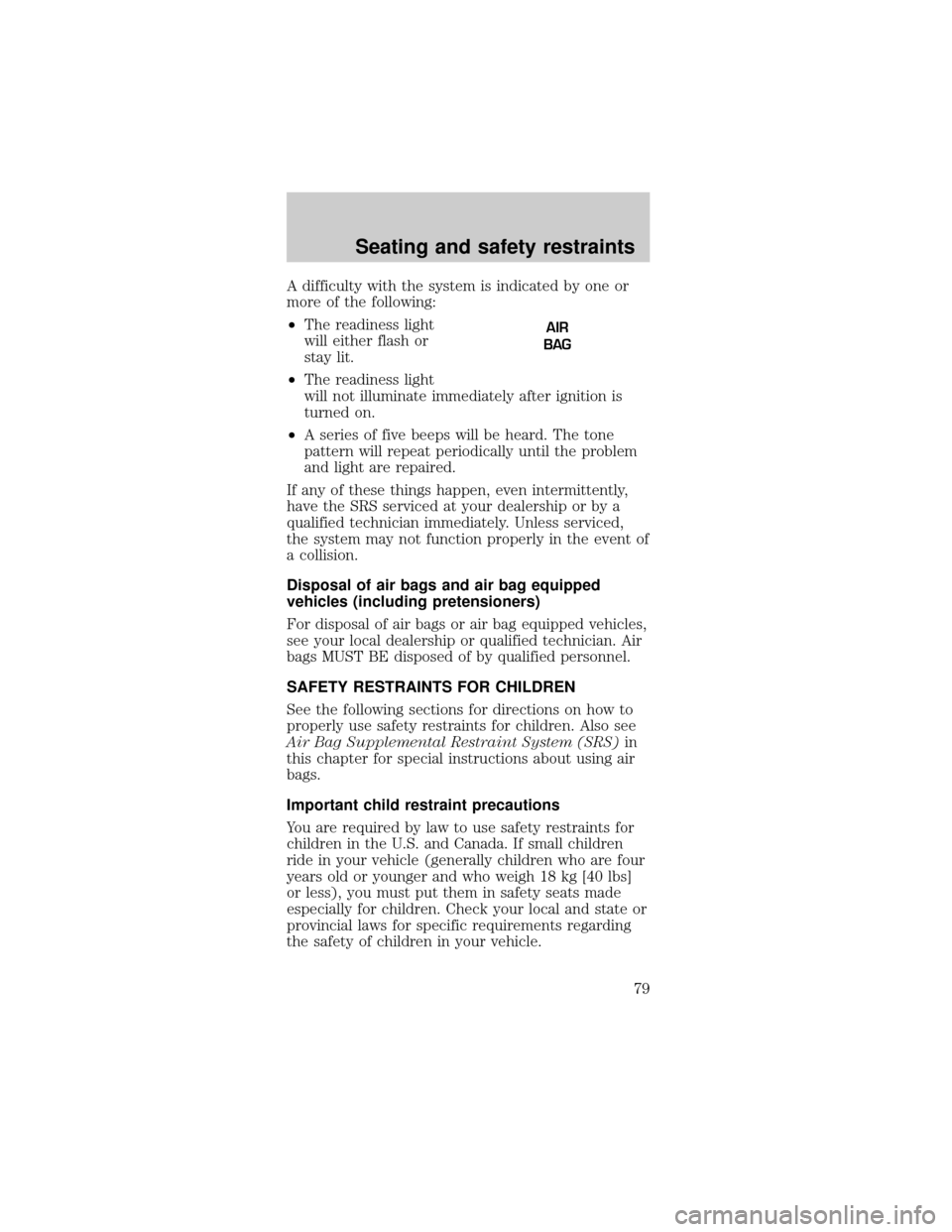
A difficulty with the system is indicated by one or
more of the following:
²The readiness light
will either flash or
stay lit.
²The readiness light
will not illuminate immediately after ignition is
turned on.
²A series of five beeps will be heard. The tone
pattern will repeat periodically until the problem
and light are repaired.
If any of these things happen, even intermittently,
have the SRS serviced at your dealership or by a
qualified technician immediately. Unless serviced,
the system may not function properly in the event of
a collision.
Disposal of air bags and air bag equipped
vehicles (including pretensioners)
For disposal of air bags or air bag equipped vehicles,
see your local dealership or qualified technician. Air
bags MUST BE disposed of by qualified personnel.
SAFETY RESTRAINTS FOR CHILDREN
See the following sections for directions on how to
properly use safety restraints for children. Also see
Air Bag Supplemental Restraint System (SRS)in
this chapter for special instructions about using air
bags.
Important child restraint precautions
You are required by law to use safety restraints for
children in the U.S. and Canada. If small children
ride in your vehicle (generally children who are four
years old or younger and who weigh 18 kg [40 lbs]
or less), you must put them in safety seats made
especially for children. Check your local and state or
provincial laws for specific requirements regarding
the safety of children in your vehicle.
AIR
BAG
Seating and safety restraints
79
Page 80 of 216

Never let a passenger hold a child on his or
her lap while the vehicle is moving. The
passenger cannot protect the child from injury in a
collision.
Always follow the instructions and warnings that
come with any infant or child restraint you might
use.
When possible, always place children under age 12
in the rear seat of your vehicle. Accident statistics
suggest that children are safer when properly
restrained in the rear seating positions than in the
front seating position.
Children and safety belts
If the child is the proper size, restrain the child in a
safety seat.
Children who are too large for child safety seats (as
specified by your child safety seat manufacturer)
should always wear safety belts.
Follow all the important safety restraint and air bag
precautions that apply to adult passengers in your
vehicle.
If the shoulder belt portion of a combination lap and
shoulder belt can be positioned so it does not cross
or rest in front of the child's face or neck, the child
should wear the lap and shoulder belt. Moving the
child closer to the center of the vehicle may help
provide a good shoulder belt fit.
Do not leave children, unreliable adults, or
pets unattended in your vehicle.
To improve the fit of lap and shoulder belts on
children who have outgrown child safety seats, Ford
recommends use of a belt-positioning booster seat
that is labelled as conforming to all Federal motor
vehicle safety standards. Belt-positioning booster
Seating and safety restraints
80
Page 81 of 216

seats raise the child and provide a shorter, firmer
seating cushion that encourages safer seating
posture and better fit of lap and shoulder belts on
the child.
A belt-positioning booster should be used if the
shoulder belt rests in front of the child's face or
neck, or if the lap belt does not fit snugly on both
thighs, or if the thighs are too short to let the child
sit all the way back on the seat cushion when the
lower legs hang over the edge of the seat cushion.
You may wish to discuss the special needs of your
child with your pediatrician.
SAFETY SEATS FOR CHILDREN
Child and infant or child safety seats
Use a safety seat that is recommended for the size
and weight of the child. Carefully follow all of the
manufacturer's instructions with the safety seat you
put in your vehicle. If you do not install and use the
safety seat properly, the child may be injured in a
sudden stop or collision.
Seating and safety restraints
81
Page 82 of 216

When installing a child safety seat:
²Review and follow
the information
presented in theAir
Bag Supplemental
Restraint System
section in this
chapter.
²Use the correct
safety belt buckle for that seating position.
²Insert the belt tongue into the proper buckle until
you hear a snap and feel it latch. Make sure the
tongue is securely fastened in the buckle.
²Keep the buckle release button pointing up and
away from the safety seat, with the tongue
between the child seat and the release button, to
prevent accidental unbuckling.
²Place seat back in upright position.
²Put the safety belt in the automatic locking mode.
Refer toAutomatic locking mode(passenger
side front and outboard rear seating positions)(if
equipped).
Ford recommends the use of a child safety seat
having a top tether strap. Install the child safety seat
in a seating position which is capable of providing a
tether anchorage. For more information on top
tether straps, refer toAttaching safety seats with
tether straps.
Carefully follow all of the manufacturer's
instructions included with the safety seat
you put in your vehicle. If you do not install and
use the safety seat properly, the child may be
injured in a sudden stop or collision.
Seating and safety restraints
82
Page 83 of 216
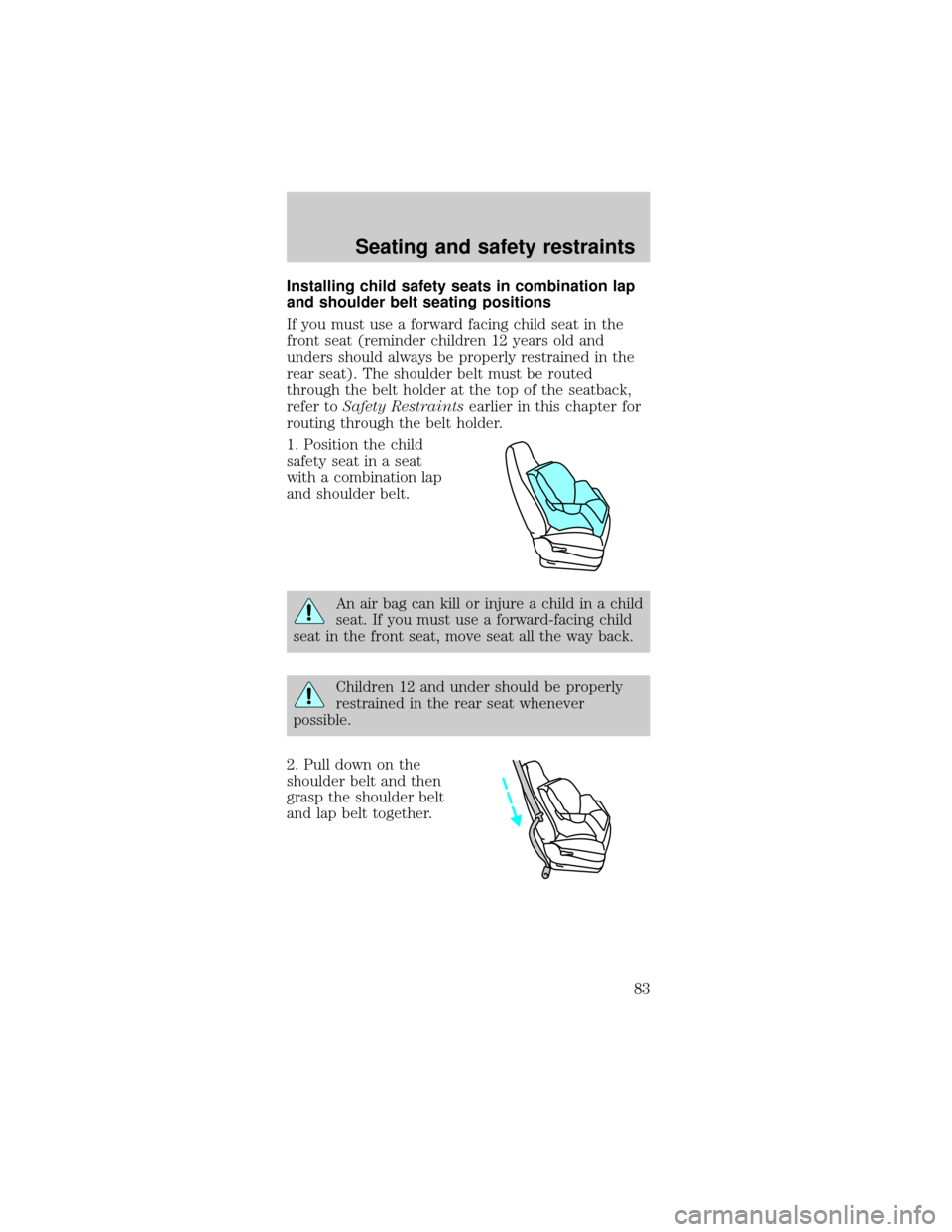
Installing child safety seats in combination lap
and shoulder belt seating positions
If you must use a forward facing child seat in the
front seat (reminder children 12 years old and
unders should always be properly restrained in the
rear seat). The shoulder belt must be routed
through the belt holder at the top of the seatback,
refer toSafety Restraintsearlier in this chapter for
routing through the belt holder.
1. Position the child
safety seat in a seat
with a combination lap
and shoulder belt.
An air bag can kill or injure a child in a child
seat. If you must use a forward-facing child
seat in the front seat, move seat all the way back.
Children 12 and under should be properly
restrained in the rear seat whenever
possible.
2. Pull down on the
shoulder belt and then
grasp the shoulder belt
and lap belt together.
Seating and safety restraints
83
Page 85 of 216
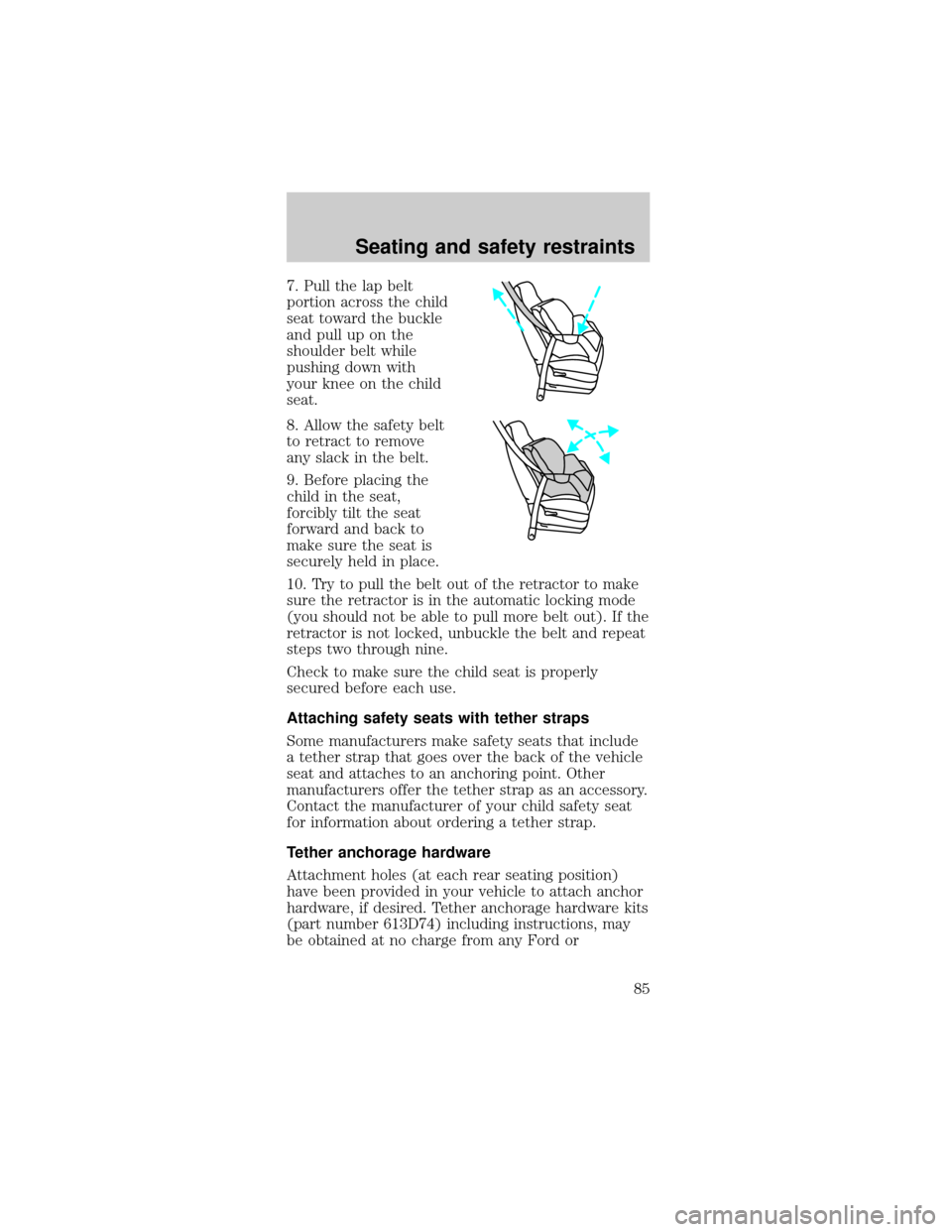
7. Pull the lap belt
portion across the child
seat toward the buckle
and pull up on the
shoulder belt while
pushing down with
your knee on the child
seat.
8. Allow the safety belt
to retract to remove
any slack in the belt.
9. Before placing the
child in the seat,
forcibly tilt the seat
forward and back to
make sure the seat is
securely held in place.
10. Try to pull the belt out of the retractor to make
sure the retractor is in the automatic locking mode
(you should not be able to pull more belt out). If the
retractor is not locked, unbuckle the belt and repeat
steps two through nine.
Check to make sure the child seat is properly
secured before each use.
Attaching safety seats with tether straps
Some manufacturers make safety seats that include
a tether strap that goes over the back of the vehicle
seat and attaches to an anchoring point. Other
manufacturers offer the tether strap as an accessory.
Contact the manufacturer of your child safety seat
for information about ordering a tether strap.
Tether anchorage hardware
Attachment holes (at each rear seating position)
have been provided in your vehicle to attach anchor
hardware, if desired. Tether anchorage hardware kits
(part number 613D74) including instructions, may
be obtained at no charge from any Ford or
Seating and safety restraints
85